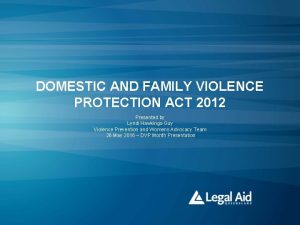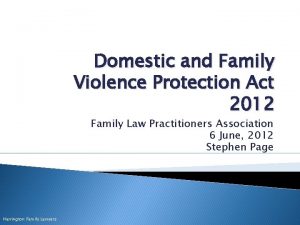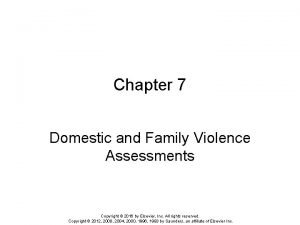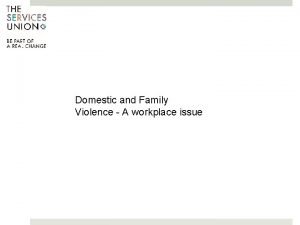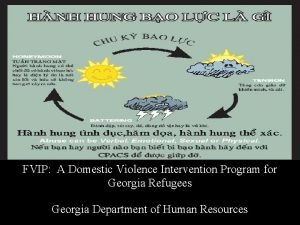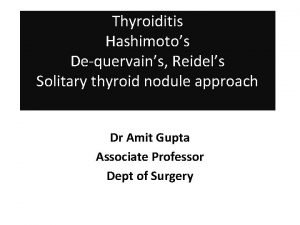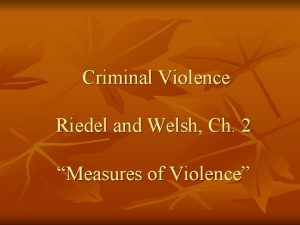Criminal Violence Riedel and Welsh Ch 8 Family











- Slides: 11

Criminal Violence Riedel and Welsh, Ch. 8 “Family Violence”

OUTLINE PATTERNS AND TRENDS EXPLANATIONS n Social Learning n Cycle of Violence n Patriarchy (Feminist Theory) n Social Isolation n Economic Dependence n Mental Health Issues n Substance Abuse INTERVENTIONS n Criminal Legal Sanctions (e. g. , mandatory arrest) n Batterer Treatment n Civil Legal Sanctions (e. g. , restraining orders) n Exposure Reduction Theory

Patterns “POWER WHEEL” – SEE HANDOUT http: //www. ncdsv. org/publications_wheel. html National Survey of Violence Against Women (NSVAW) n n n Interviews with a random sample of 8, 000 men and 8, 000 women. About 22% of women were victims of physical assaults by their partners; in contrast to 7% of men. Of those who reported partner assaults, 42% of women were injured, compared to 20% of the men.

Victim/Offender Relationship: NCVS, 2010 Women are much more likely than men to be assaulted by someone that they know.

Figure 8. 1: # of homicides involving intimate partners dropped significantly from 1976 -2004 (spouses: -64%).

Intimate Partner Violence in Other Countries n World Health Organization (WHO) did a survey on women’s health and domestic violence in 11 countries (n = 24, 000). n n n Trained female interviewers selected according to emotional maturity, ability to engage with people of different backgrounds in an empathetic and non-judgmental manner, social skills. The most frequent act of violence was being slapped by an intimate partner, ranging from 9 percent in Japan to 52 percent in Peru. Women experiencing severe physical violence (hit with a fist, kicked, dragged, use or threatened use of a weapon) ranged from 4 percent in Japan to 49 percent in Peru. Three-fourths of the respondents in urban settings felt that violence was never justified; only one-fourth of the respondents in more rural settings thought so. The most frequent justification reported was “Infidelity, ” followed by “Disobeying a Husband. ”

Explanations Video Clips Power and Control: Domestic Violence in America n n http: //www. youtube. com/watch? v=7 v 2 Lm. M_FO-U http: //www. powerandcontrolfilm. com/all%20 videos/ Feminist Theory (Patriarchy) Historical and physical advantages enjoyed by males facilitate greater power and control n n n Social Isolation Economic Dependence Psychological problems (e. g. , severe depression or mental illness) Substance Abuse (strong correlation, but not a causal fact) Social Learning n Cycle of Violence: childhood history of physical abuse predisposes the survivor to violence in later years.

Widom (2001): Cycle of Violence Updated https: //www. ncjrs. gov/pdffiles 1/nij/184894. pdf n The “cycle of violence” hypothesis suggests that a childhood history of physical abuse predisposes the survivor to violence in later years. n 1. 2. The study followed 1, 575 cases from childhood through young adulthood, comparing the arrest records of two groups: Study group: 908 substantiated cases of childhood abuse or neglect processed by the courts and tracked through official criminal records over approximately 25 years. Comparison group: 667 children, not officially recorded as abused or neglected, matched to the study group according to sex, age, race, and family socioeconomic status.

Widom (2001): Cycle of Violence Updated n Although many individuals in both groups had no juvenile or adult criminal record, being abused or neglected as a child increased the likelihood of: n n n Arrest as a juvenile (by 59 %), Arrest as an adult (by 28 %), and Arrest for a violent crime (by 30 %). This study showed that victims of neglect were also likely to develop later violent criminal behavior. If violence is begotten not only by violence, but also by neglect, far more attention needs to be devoted to the families of children who are abandoned and neglected.

Interventions Criminal Legal Sanctions (e. g. , mandatory arrest deterrence? ) Law Enforcement Approaches http: //www. powerandcontrolfilm. com/all%20 videos/ Collaborative Approaches: Duluth project http: //vimeo. com/11109979 Batterer Treatment (e. g. , anger control, awareness about power and control issues). http: //vimeo. com/11110943 http: //vimeo. com/11113365 n Evaluation results so far have been disappointing. Civil Legal Sanctions (e. g. , restraining orders): n Have not proven very effective in preventing violence.

Interventions (cont. ) Exposure Reduction Theory: Factors that reduce exposure to violent relationships (e. g. , higher divorce rate, lower marriage rate, greater economic independence of women) and provide alternatives to violence (e. g. , shelters, hotlines, legal advocacy) have all helped to reduce domestic violence. Public Service Announcements (PSA’s) n n n http: //www. youtube. com/watch? v=njx-n 6 Ssd. V 8 http: //www. youtube. com/watch? v=SPz. VUGE 3 dds http: //video. foxnews. com/v/3812142293001/nfl-airs-anti-domesticviolence-psa-during-games/? #sp=show-clips https: //www. youtube. com/watch? v=5 Z_z. WIVRIWk
 Domestic and family violence protection act 2012
Domestic and family violence protection act 2012 S68r family law act
S68r family law act Chapter 7 domestic and family violence assessment
Chapter 7 domestic and family violence assessment Electric circuits nilsson
Electric circuits nilsson Family violence intervention program atlanta
Family violence intervention program atlanta Adolescent family violence program
Adolescent family violence program Family violence
Family violence Fvip georgia
Fvip georgia Riedel's thyroiditis
Riedel's thyroiditis Riedel ryszard biografia
Riedel ryszard biografia Ryszard riedel cytaty
Ryszard riedel cytaty Marcel riedel
Marcel riedel
